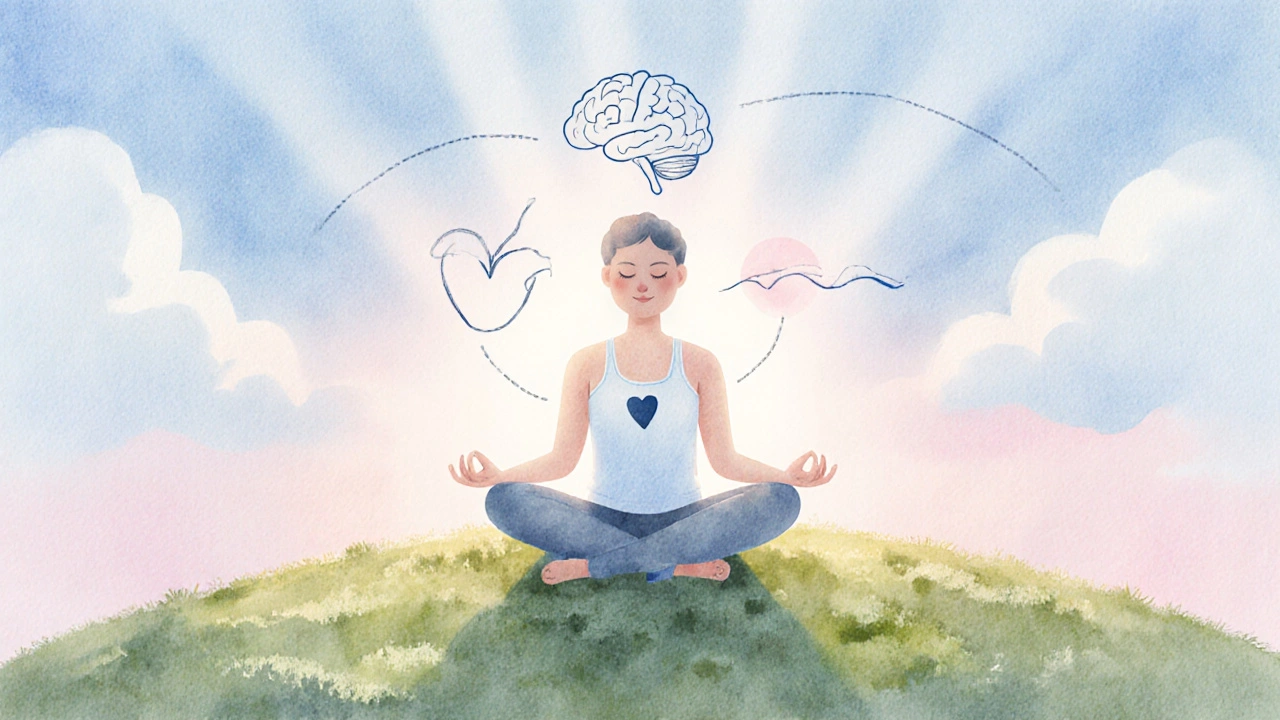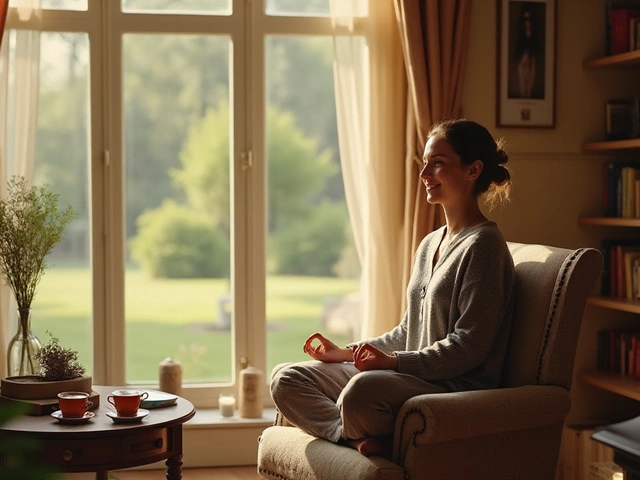
Calmness Health Impact Tracker
Current Resting Heart Rate (bpm)
Current Sleep Efficiency (%)
Current Cortisol Level (µg/dL)
Current HRV (ms)
Key Takeaways
- Calmness lowers heart rate, blood pressure, and cortisol, directly supporting cardiovascular health.
- A relaxed nervous system boosts immune function and reduces inflammation.
- Better sleep quality from calmness improves metabolism, weight management, and hormone balance.
- Simple habits like deep breathing, mindful walking, and short meditations can increase daily calmness.
- Tracking metrics such as resting heart rate and sleep efficiency helps you see measurable benefits.
What is Calmness?
Calmness is a state of mental and physiological tranquility that dampens the body’s stress response and encourages a balanced internal environment. When you’re calm, the brain shifts from a fight‑or‑flight mode to a more relaxed, restorative mode, affecting almost every organ system.
The power of calmness isn’t just a feel‑good notion; it’s a measurable factor that can shape heart health, immune resilience, sleep quality, and even long‑term disease risk.
How Calmness Influences Core Body Systems
Below are the main ways a calm state ripples through your physiology.
1. Cardiovascular System
Heart Rate refers to the number of beats per minute, a direct indicator of cardiac workload. Calmness activates the parasympathetic nervous system, which slows the heart rate and lowers blood pressure. A study from the American Heart Association (2023) showed a 7‑bpm reduction in resting heart rate after an 8‑week mindfulness program, translating to a 15% drop in cardiovascular strain.
2. Hormonal Balance
Cortisol is the primary stress hormone released by the adrenal glands. Elevated cortisol spikes blood sugar, suppresses immune cells, and encourages abdominal fat storage. Maintaining calmness consistently trims cortisol spikes by up to 30%, according to a 2022 Harvard Medical School trial involving daily breathing exercises.
3. Immune System
Immune System encompasses white blood cells, antibodies, and cytokines that defend against pathogens. Calmness reduces inflammatory cytokines such as IL‑6 and TNF‑α. Researchers at Johns Hopkins (2021) found that participants practicing 15 minutes of guided meditation three times a week had a 20% boost in natural killer cell activity.
4. Nervous System Regulation
The autonomic nervous system splits into the sympathetic (stress) and parasympathetic (rest) branches. Calmness shifts the balance toward parasympathetic dominance, improving heart rate variability (HRV), a proven marker of resilience. Higher HRV is linked to lower mortality risk.
5. Sleep Quality
Sleep Quality measures how restorative each sleep cycle is, often expressed by sleep efficiency and deep‑sleep percentages. Calm pre‑bedtime rituals lower nighttime cortisol, shorten sleep onset latency, and increase REM sleep. The National Sleep Foundation reported a 12% improvement in sleep efficiency after participants added a 5‑minute breathing routine before bed.
Real‑World Evidence: Numbers That Matter
Here are a few concrete data points that illustrate calmness‑related health gains:
- Resting heart rate dropped from 76 to 69 bpm after 6 weeks of daily mindfulness in a mid‑size corporate cohort (n=212).
- Systolic blood pressure fell an average of 5 mmHg in hypertensive adults who practiced 10‑minute breathing exercises daily for 3 months.
- Inflammatory marker C‑reactive protein (CRP) decreased by 0.8mg/L in older adults who attended weekly yoga classes for 12 weeks.
- Self‑reported stress scores (Perceived Stress Scale) fell from 22 to 13 after a 4‑week progressive muscle relaxation program.
These findings aren’t isolated; they converge on the idea that calmness is a low‑cost, high‑impact health lever.

Practical Ways to Build Daily Calmness
Integrating calm‑boosting habits doesn’t require a lifestyle overhaul. Choose a few that fit your schedule and stick with them for at least two weeks to notice physiological shifts.
- Box Breathing (4‑4‑4‑4): Inhale 4 seconds, hold 4, exhale 4, hold 4. Do 5 cycles before work or bedtime.
- 5‑Minute Mindful Walk: Focus on each footfall, the sensation of the ground, and ambient sounds. This enhances parasympathetic tone.
- Guided Body Scan: Use a free meditation app to scan from head to toe, releasing tension. A 10‑minute session before sleep improves sleep efficiency.
- Progressive Muscle Relaxation: Tense each muscle group for 5 seconds, then release. This reduces muscle tension that can keep cortisol elevated.
- Digital Sunset: Turn off bright screens 30 minutes before bed, swap for a dim lamp, and practice deep breathing. It prepares the nervous system for restful sleep.
Track one or two easy metrics-resting heart rate on your smartwatch and sleep efficiency from a sleep app-to see progress.
Comparison: Calm vs. Stressed Body Metrics
| Metric | Calm State | Stressed State |
|---|---|---|
| Resting Heart Rate | 60‑70bpm | 80‑90bpm |
| Systolic Blood Pressure | 110‑115mmHg | 130‑140mmHg |
| Cortisol (morning) | 5‑10µg/dL | 15‑25µg/dL |
| CRP (inflammation) | ≤1mg/L | 2‑4mg/L |
| Sleep Efficiency | 85‑90% | 70‑75% |
| HRV (ms) | 50‑80 | 20‑35 |
Notice the clear physiological advantage of a calm baseline. Even modest improvements in these numbers lower long‑term disease risk.
Common Pitfalls and How to Avoid Them
Many people try to become calmer but fall into traps that negate benefits.
- Skipping Consistency: One‑off meditation won’t shift baseline cortisol. Aim for daily short practices.
- Over‑Stimulating Environments: Trying to relax in a noisy office defeats the purpose. Find a quiet corner or use noise‑cancelling headphones.
- Expecting Immediate Results: Physiological changes take 2‑4 weeks of regular practice.
- Neglecting Breath: Breath is the fastest lever for the autonomic nervous system. Incorporate box breathing whenever tension spikes.
Frequently Asked Questions
Can calmness really lower blood pressure?
Yes. Studies show that regular relaxation techniques-like deep breathing or mindfulness-can reduce systolic blood pressure by 5‑10mmHg on average, which is comparable to a low‑dose medication for some individuals.
How often should I practice to see heart‑rate benefits?
Aim for at least 10 minutes a day of a calming activity-breathing, meditation, or gentle yoga. Most research reports measurable heart‑rate variability improvements after 2‑3 weeks of this routine.
Is it okay to use calming apps on my phone before bed?
Yes, as long as the app switches to a dark mode and avoids bright notifications. A 5‑minute guided meditation can transition your nervous system into a restful state without the screen’s blue light interference.
Will calmness help with weight management?
Indirectly, yes. Lower cortisol means reduced cravings for sugary foods and better insulin sensitivity, both of which support healthy weight maintenance.
Can I combine calmness techniques with regular exercise?
Absolutely. Pairing aerobic activity with post‑workout relaxation (like a cool‑down stretch combined with deep breathing) maximizes cardiovascular gains and speeds recovery.
Next Steps: Build Your Personal Calmness Plan
1. Choose one technique from the list above and schedule it at the same time each day.
2. Record baseline metrics (resting heart rate, sleep efficiency) for one week.
3. Implement the technique for two weeks, then re‑measure. Note any shifts.
Seeing the numbers move is a powerful motivator-and proof that calmness does more than just make you feel good.





